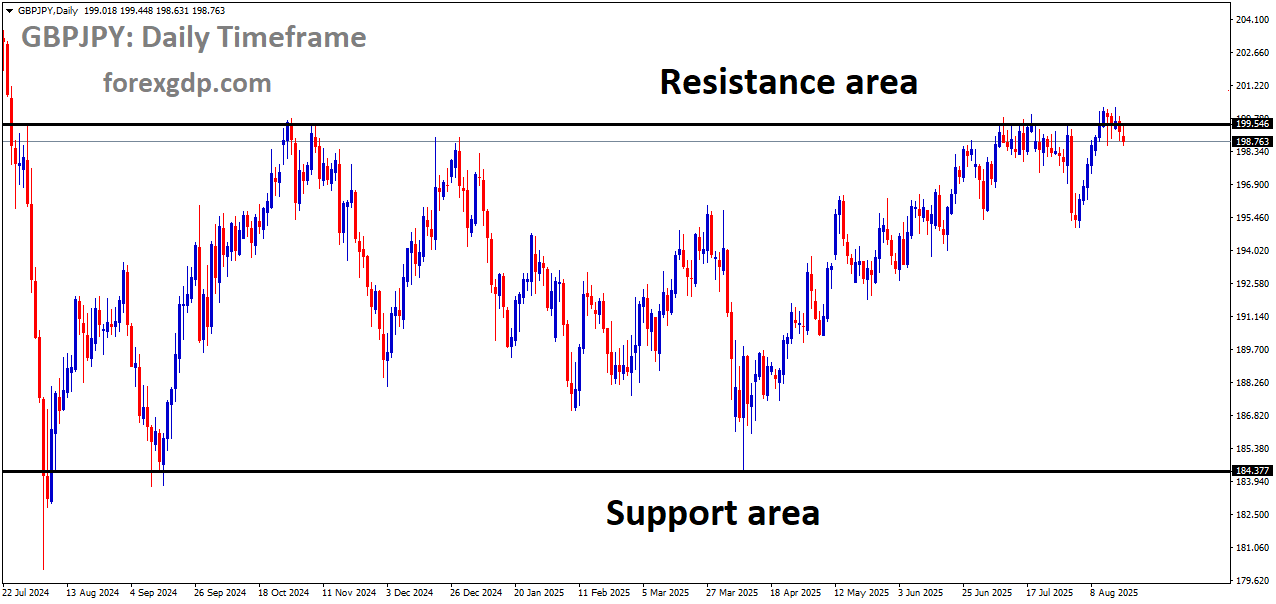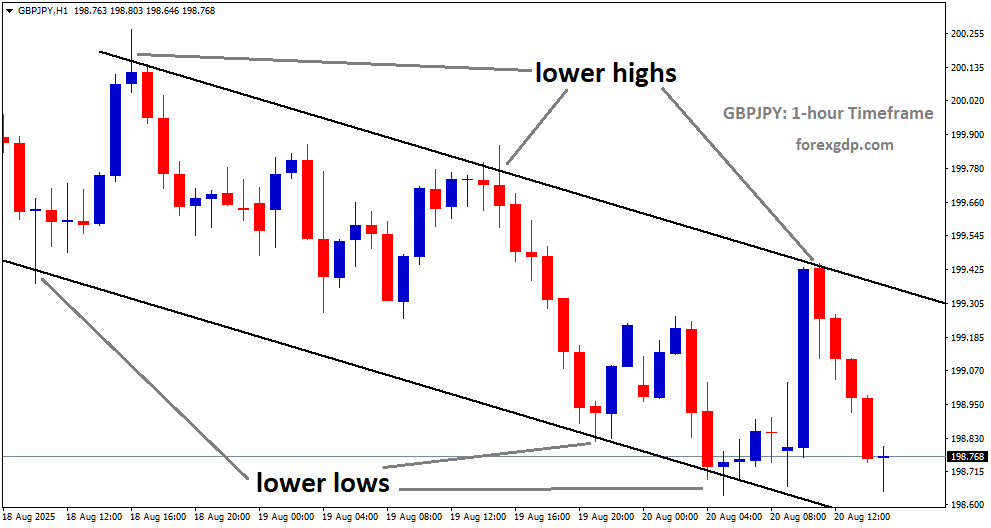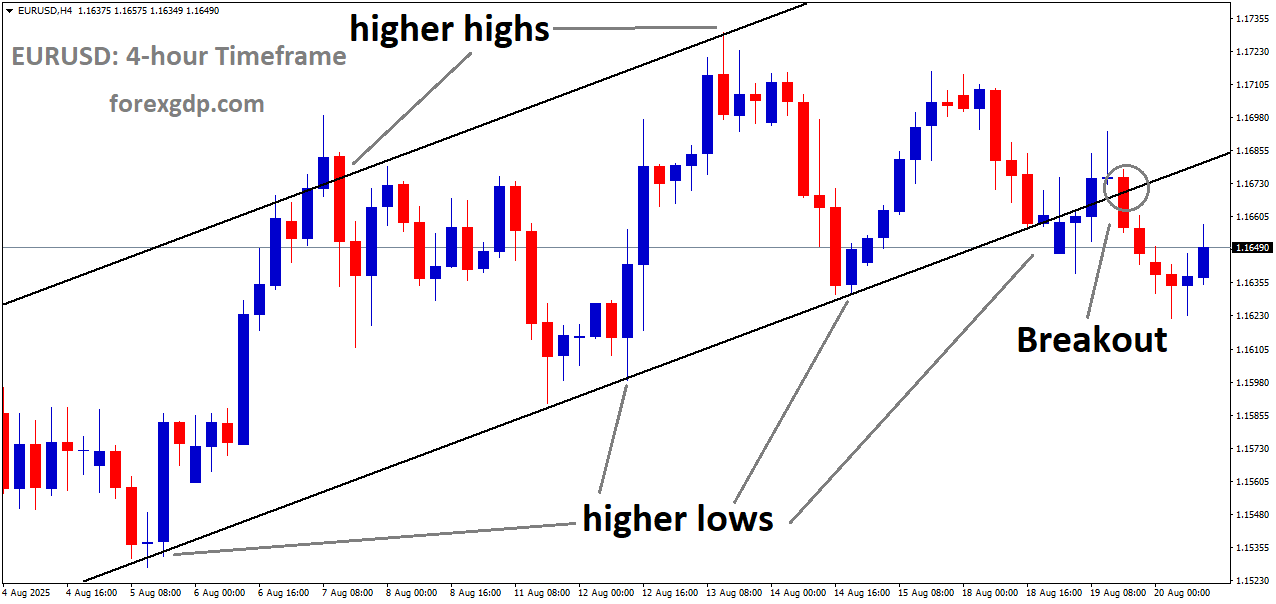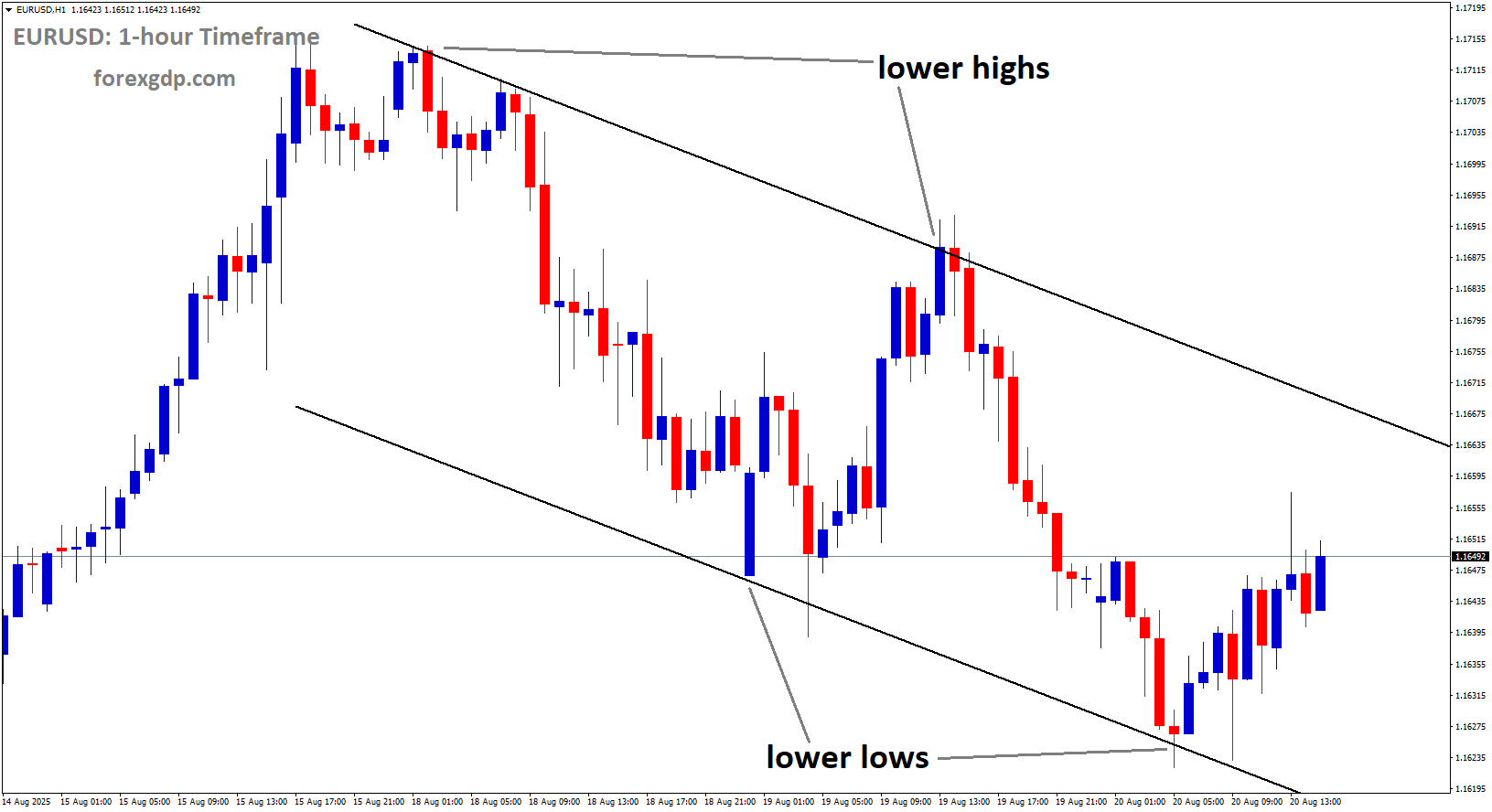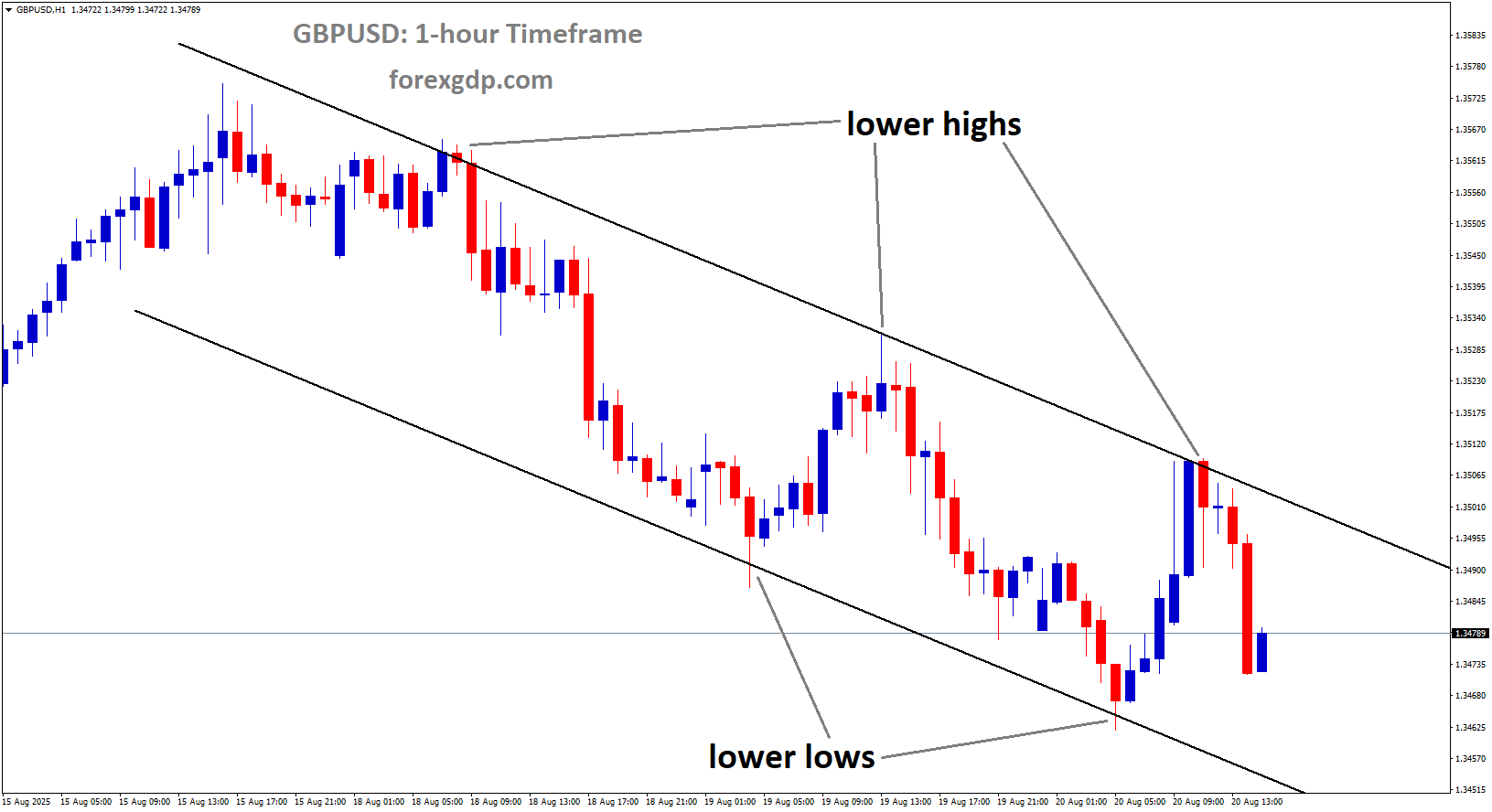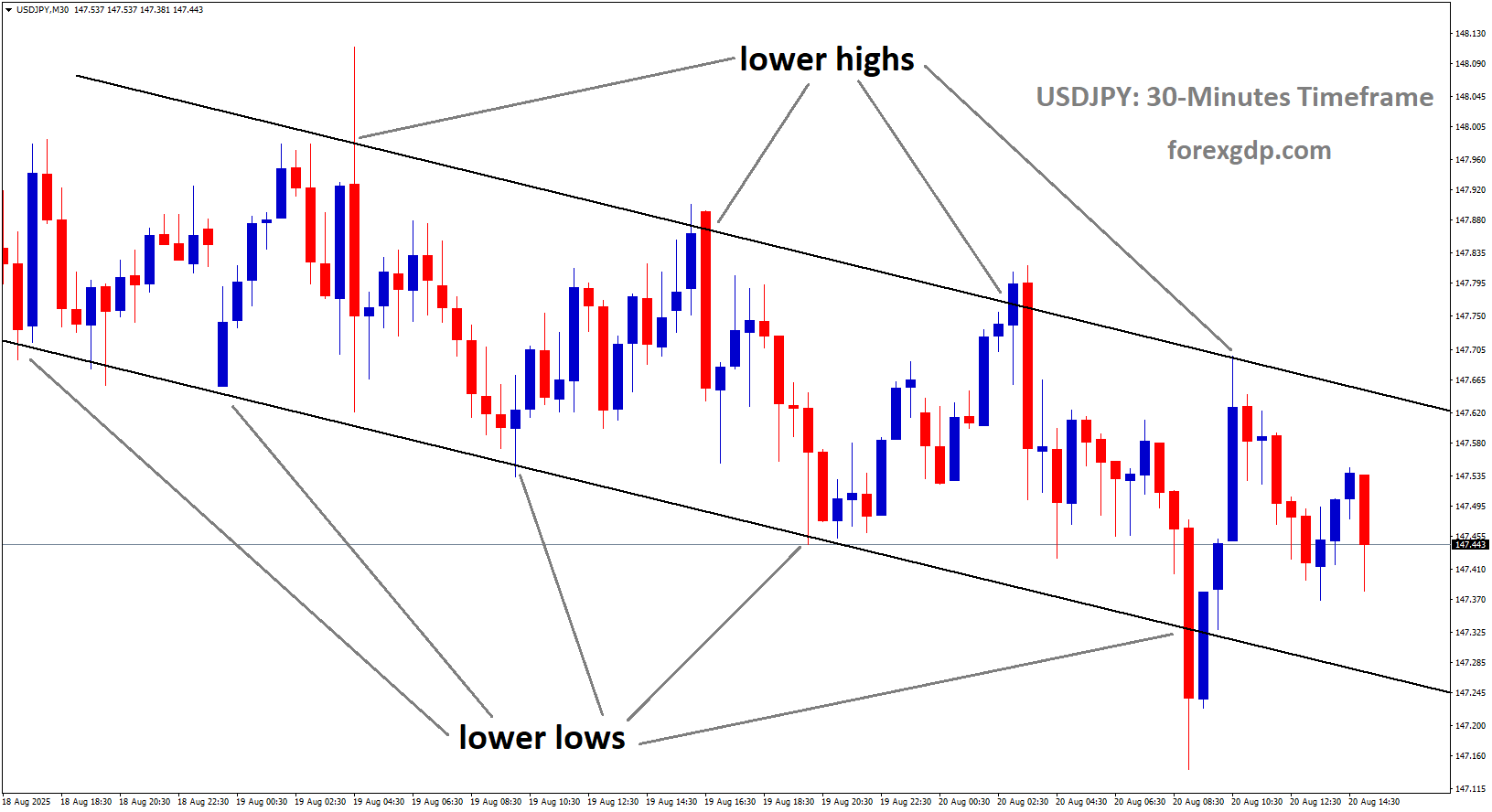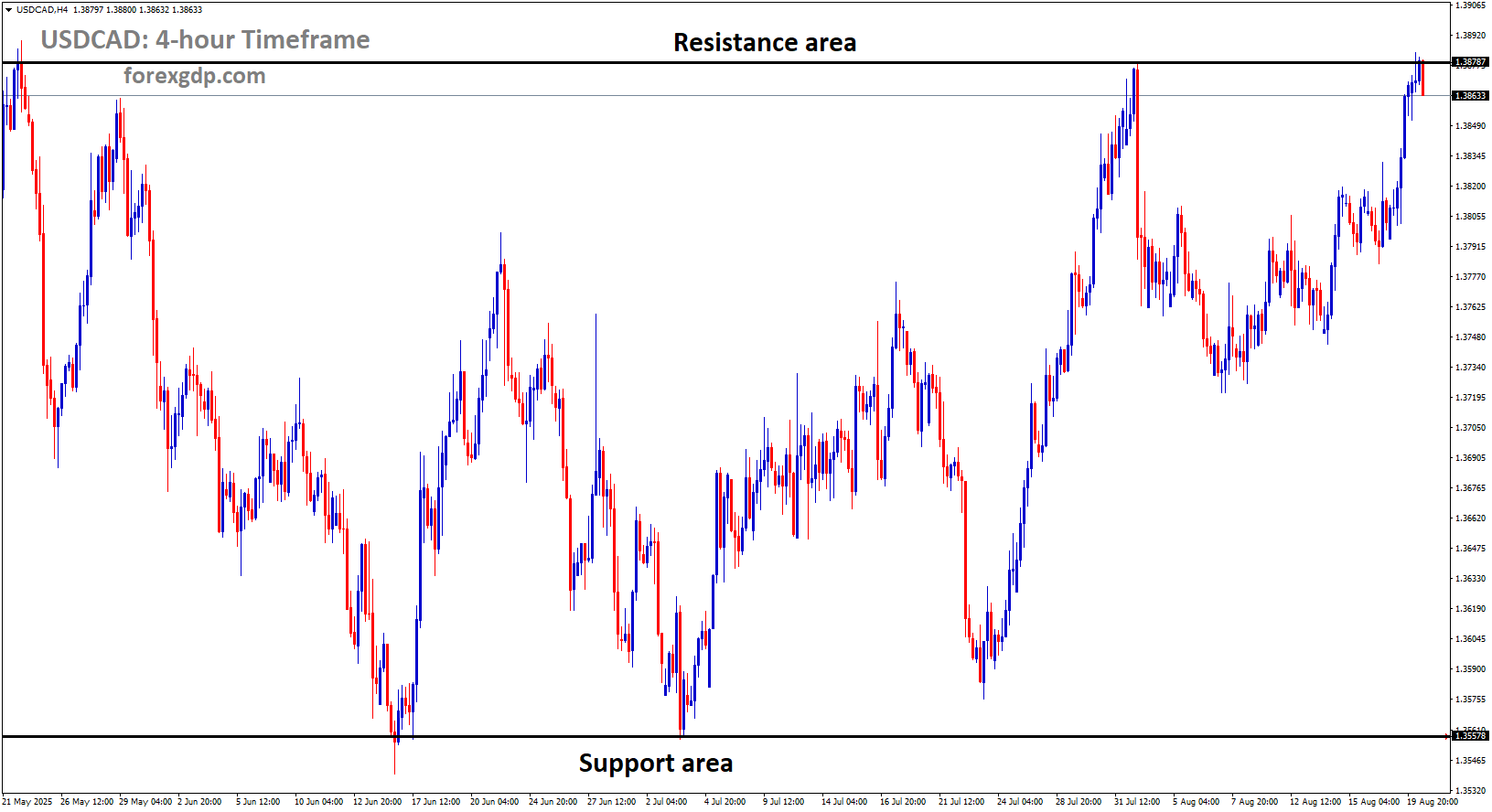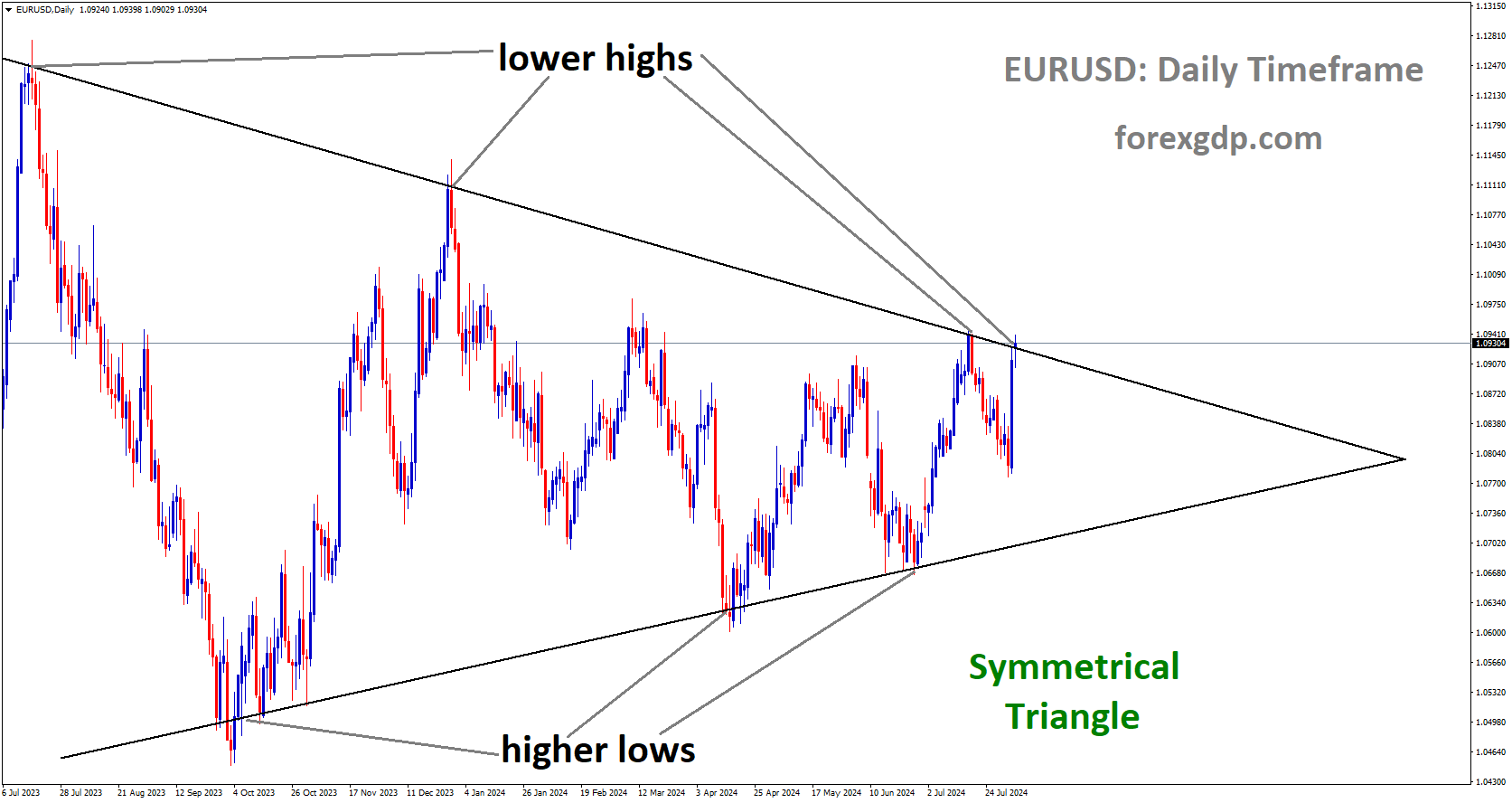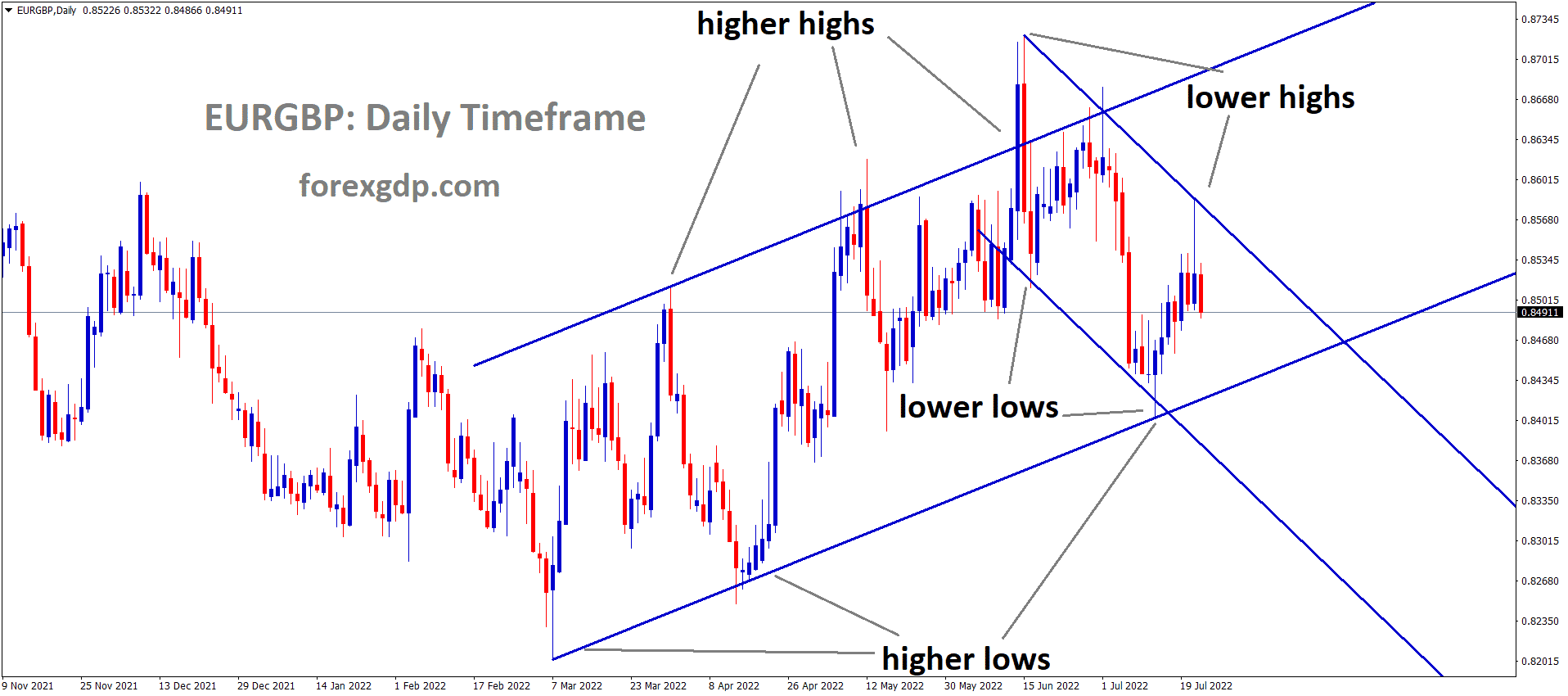GBPJPY is moving in a box pattern, and the market has reached the resistance area of the pattern
Daily Forex Trade Setups Aug 20, 2025
Stay on top of market trends with our Daily Forex Trade Setups (Aug 20, 2025)
GBPJPY Rebounds With Pound Lifted by Higher UK Inflation Data
The GBP/JPY pair has recently gained attention as the Pound Sterling showed strength following the release of fresh UK inflation numbers. The movement wasn’t just about currency fluctuations—it’s a direct reflection of how economic data shapes investor confidence and expectations. Let’s break it down in a simple way so you can understand why this development matters, what’s driving it, and what might happen next.
UK Inflation Surprises Investors
The highlight of the week came from the United Kingdom’s Consumer Price Index (CPI) report for July. Both the headline CPI and the core CPI rose 3.8% year-on-year, which was slightly higher than what most analysts had expected.
This figure may sound like just another percentage, but in the world of finance, even a small difference can create big waves. Why? Because inflation directly impacts what central banks, like the Bank of England (BoE), decide to do with interest rates.
For months, the BoE has been signaling a “gradual and careful” approach toward easing its monetary policy. In simple terms, they’ve been cautious about cutting interest rates too fast. With inflation picking up again, the central bank could slow down or even pause any plans for lowering rates further this year. That makes the Pound stronger, as higher interest rates typically attract investors looking for better returns.
Why Inflation Matters So Much
Inflation doesn’t just mean higher grocery bills—it also influences borrowing, mortgages, business costs, and consumer confidence. If inflation sticks around longer than expected, central banks must stay aggressive to keep it in check. For traders and investors, this adds an extra layer of uncertainty and opportunity, especially in currency pairs like GBP/JPY.
Bank of England’s Concerns About Rising Costs
Earlier this month, BoE Governor Andrew Bailey raised concerns about inflation expectations being pushed higher due to rising food and energy prices. This isn’t a small issue because once consumers and businesses start expecting higher inflation, it becomes harder to bring it down.
Adding to the concerns, the BoE also increased its one-year forward inflation projections, lifting them from 2.4% to 2.7%. While that might still be close to their 2% long-term target, it shows they believe inflation could remain above comfort levels for longer than previously thought.
For anyone watching the Pound Sterling, these comments signal that the central bank may resist aggressive rate cuts, and this possibility naturally boosts demand for the currency.
What’s Next for the UK Economy?
Looking ahead, investors are keeping their eyes on the UK’s flash Purchasing Managers’ Index (PMI) data, due soon. This report will give fresh insights into how businesses in manufacturing and services are performing. If the PMI data comes in stronger than expected, it could reinforce optimism about the UK economy. On the other hand, weak numbers could raise new doubts about growth prospects.
The combination of stronger inflation but uncertain business performance creates a mixed picture. For GBP/JPY traders, this mix often results in short-term volatility.
Japan’s Inflation Picture Also in Focus
On the other side of this currency pair, Japan’s National CPI data for July is scheduled to be released soon. Current expectations suggest inflation excluding fresh food may come in at around 3%.
If Japanese inflation shows signs of cooling, it might reduce pressure on the Bank of Japan (BoJ) to adjust its ultra-loose monetary policy. For decades, Japan has battled low inflation and slow growth, which is why its central bank has been more cautious about raising interest rates compared to others.
Why Japan’s Data Matters to GBP/JPY
Even though UK news is dominating the spotlight, Japanese inflation numbers can’t be ignored. If inflation softens, it could make the Japanese Yen weaker, giving an extra lift to GBP/JPY. On the flip side, stronger-than-expected inflation in Japan would raise speculation about potential tightening from the BoJ, which could strengthen the Yen.
The Bigger Picture: What It Means for Investors
When we look at GBP/JPY, it’s not just about the numbers flashing on a screen. It’s about two very different economic stories colliding.
-
United Kingdom: Battling inflation that refuses to settle comfortably, with the BoE stuck between controlling rising prices and avoiding too much damage to growth.
-
Japan: Struggling to sustain moderate inflation after years of ultra-loose monetary policy, with the BoJ still hesitant to move aggressively.
This creates a tug-of-war effect. The Pound gets strength from higher inflation and the possibility of the BoE holding off on rate cuts, while the Yen’s movement depends on whether Japanese inflation justifies any policy shift from the BoJ.
For investors, this situation means opportunities—but also risks. Currency markets are often quick to react to fresh data, and that makes economic reports like CPI and PMI especially influential.
GBPJPY is moving in a descending channel
Final Summary
The recent bounce in GBP/JPY highlights how powerful economic data can be in shaping currency movements. The UK’s higher-than-expected inflation has strengthened the Pound by making it less likely the Bank of England will rush into cutting interest rates. Meanwhile, all eyes are on Japan’s upcoming CPI report, which could shift sentiment for the Yen.
In simple terms, the GBP/JPY pair reflects a battle between a UK economy wrestling with persistent inflation and a Japanese economy cautiously watching its own price trends. For traders and investors, this means staying alert to every data release, as each report has the power to shift momentum one way or another.
EURUSD Slides as Euro Gets Little Lift from Steady CPI Data
The Euro continues to face challenges in global markets as traders weigh ongoing geopolitical tensions, economic data from Europe, and upcoming signals from the U.S. Federal Reserve. While many hoped for stronger momentum from the Eurozone, recent developments have kept the common currency under pressure, especially against the U.S. Dollar. Let’s dive into what’s really happening, why the Euro is struggling, and what factors traders are watching closely.
Eurozone Inflation Holds Steady, But Growth Concerns Linger
The latest Consumer Price Index (CPI) figures from Eurostat confirmed that inflation in the Eurozone stayed steady in July. On the surface, that may seem like stability, but it doesn’t necessarily signal strong growth. The European Central Bank (ECB) has been carefully monitoring inflation trends, especially after months of economic pressure linked to global trade uncertainties and political instability.
EURUSD has broken the uptrend channel on the downside
ECB President Christine Lagarde recently addressed concerns at the World Economic Forum in Geneva. She emphasized that while the Eurozone economy has shown resilience this year, growth could slow down in the coming months. According to her, ongoing trade negotiations and global economic shifts leave room for uncertainty. This cautious outlook, combined with the lack of new policy announcements, has failed to provide the Euro with much-needed support.
Why Inflation Stability Isn’t Enough
A steady inflation rate means prices aren’t rising or falling dramatically, but it doesn’t guarantee strong consumer spending or business growth. In fact, if growth slows while inflation remains stable, households may feel the pinch of higher living costs without enjoying the benefits of expanding job opportunities or wage growth. This balance leaves the Euro vulnerable to external market forces, particularly when compared to the U.S. Dollar, which thrives in times of uncertainty.
Geopolitical Tensions: Ukraine Peace Talks and Market Sentiment
Beyond economic data, geopolitics are playing a major role in shaping currency movements. Recently, hopes for progress in Ukraine cooled after the Kremlin downplayed the possibility of an immediate meeting between Russian President Vladimir Putin and Ukrainian President Volodymyr Zelenskyy. Earlier optimism had been sparked by talks involving U.S. leaders, but Russia’s more cautious stance has left the situation in limbo.
For investors, unresolved geopolitical tensions often translate into risk aversion. When uncertainty rises, traders typically move away from riskier assets like the Euro and shift toward safe-haven currencies such as the U.S. Dollar. This dynamic explains part of the Dollar’s recent strength and the Euro’s struggle to rebound.
Why Geopolitics Hit Currencies Hard
Global conflicts and political standoffs matter because they shape investor confidence. If traders expect instability in a region, they tend to avoid assets tied to it. The Eurozone’s close proximity to the Ukraine conflict means that even small shifts in peace negotiations can ripple through European markets and affect the Euro directly.
The U.S. Dollar Finds Strength in Risk Aversion
The U.S. Dollar has been benefiting from a wave of risk aversion across global markets. With concerns about government intervention in the tech sector weighing on Wall Street, U.S. equities recently sold off. This decline spilled over into Asian and European markets, pushing investors to seek safer assets.
The Dollar, often seen as the world’s most reliable safe-haven currency, gains traction in these situations. Even without major U.S. economic releases this week, the combination of geopolitical worries and investor caution has been enough to lift the Dollar higher against its peers, including the Euro.
FOMC Minutes and Jackson Hole Symposium
Another critical factor drawing attention is the Federal Reserve’s upcoming releases. The minutes from the most recent Federal Open Market Committee (FOMC) meeting are expected to highlight divisions among policymakers. While these minutes may not have an immediate impact on markets, traders are eagerly awaiting Fed Chair Jerome Powell’s speech at the Jackson Hole symposium. His remarks could provide fresh clues about the Fed’s monetary policy outlook, including potential interest rate adjustments.
For the Euro, this means continued pressure. If Powell signals a more aggressive approach to controlling inflation or maintaining U.S. economic strength, the Dollar could extend its gains, leaving little room for the Euro to recover in the near term.
Eurozone vs. U.S. Outlook: A Tale of Two Economies
At the heart of the Euro’s struggles is the contrast between the Eurozone and the U.S. economy. On one side, Europe is facing slower growth prospects, steady but unremarkable inflation, and ongoing geopolitical risks. On the other, the U.S. continues to show resilience, with its currency strengthened by global demand for safety and expectations of decisive monetary policy action.
This imbalance creates a difficult environment for the Euro. Without stronger signs of growth or stability from within Europe, it’s hard for the common currency to mount a sustainable comeback against the Dollar.
What Traders Are Watching Next
-
ECB Policy Shifts – Any indication of stimulus adjustments or a firmer stance from the ECB could influence the Euro’s direction.
-
U.S. Federal Reserve Updates – Powell’s Jackson Hole speech remains a key event for market watchers.
-
Geopolitical Developments – Any breakthrough or setback in Ukraine peace talks will immediately reflect in the Euro’s performance.
EURUSD is moving in a downtrend channel, and the market has rebounded from the lower low area of the channel
Final Summary
The Euro remains under pressure as traders weigh a mix of economic data, geopolitical uncertainty, and the upcoming signals from the U.S. Federal Reserve. While Eurozone inflation has held steady, concerns about slower growth and ongoing global instability limit optimism. Meanwhile, the U.S. Dollar continues to benefit from its status as a safe-haven currency, gaining strength as risk aversion spreads through global markets.
Looking ahead, much will depend on whether the Eurozone can show stronger signs of resilience and whether geopolitical tensions ease. For now, however, the balance of power remains tilted in favor of the U.S. Dollar, leaving the Euro struggling to gain meaningful traction.
GBPUSD Jumps as Rising UK Inflation Fuels Pound Momentum
The Pound Sterling has been making headlines again, and this time it’s all about inflation. Recent data from the UK showed that consumer prices grew more than expected in July, giving the British currency a strong push against its global peers. With investors eyeing upcoming reports and major speeches, the market is buzzing with speculation on what comes next for both the Bank of England (BoE) and the Federal Reserve (Fed). Let’s dive into the details and unpack what’s really happening here.
GBPUSD is moving in a downtrend channel
UK Inflation Sparks Fresh Momentum for the Pound
The big story starts with the UK Consumer Price Index (CPI) figures for July. According to the Office for National Statistics (ONS), inflation rose faster than economists predicted. Both the headline CPI and the core CPI – which leaves out items like food and energy – climbed to an annual rate of 3.8%. While the increase might look small compared to last month, even a slight difference carries a big weight in financial markets.
Why does this matter so much? Higher inflation suggests that the cost of living in the UK is still growing at a stubborn pace. For the Bank of England, this means more pressure to keep monetary policies tight, instead of rushing into aggressive interest rate cuts.
Services Inflation – A Key Detail
One of the most striking parts of the report is the services sector, where inflation hit 5.0% year-on-year. This sector is often watched closely by the BoE because it reflects domestic pressures within the economy, such as wages and service-related costs. When services inflation rises, it signals that inflation isn’t just about global energy or food prices—it’s embedded in the day-to-day UK economy.
What the Bank of England Is Thinking
At the BoE’s last policy meeting, Governor Andrew Bailey expressed concerns that consumer expectations around inflation were being shaken by rising food and energy bills. In fact, the central bank even revised its forward-looking CPI projections, raising its one-year forecast from 2.4% to 2.7%.
Earlier this month, the BoE cut borrowing costs slightly, reducing rates by 25 basis points. But here’s the interesting part—it wasn’t a unanimous decision. The cut passed by a slim margin, showing how divided policymakers are about whether inflation is cooling fast enough.
According to a Reuters poll, most analysts believe the BoE will only make one more interest rate cut this year. That means officials are still very cautious, carefully balancing the need to support economic growth with the responsibility of controlling inflation.
The Pound’s Recovery Against the Dollar
The Pound Sterling’s rally didn’t happen in isolation—it came as part of a broader tug-of-war with the US Dollar. After the hot UK inflation report was released, the Pound regained strength against the Dollar, bouncing back from earlier losses.
Meanwhile, the US Dollar Index has been hovering near recent highs. The Dollar’s strength is largely tied to expectations around what the Federal Reserve will do next. Investors are paying close attention to Fed Chair Jerome Powell’s upcoming speech at the Jackson Hole Symposium, a yearly event that often sets the tone for US monetary policy.
What’s Happening in the United States
In the US, the conversation also revolves around inflation, but with a slightly different backdrop. Powell has been fairly consistent in saying the Fed isn’t rushing into big policy changes. Part of the caution comes from uncertainty over how tariff policies might impact inflation and growth.
The July inflation data in the US suggested tariffs haven’t had a huge effect yet, but the Producer Price Index (PPI) showed that businesses are starting to pass higher import costs to consumers. That’s something the Fed cannot ignore.
Market tools like the CME FedWatch are pointing to a strong chance—around 85%—that the Fed could cut interest rates by a quarter point at its September meeting. If that happens, it would bring US borrowing costs down into the 4.00%–4.25% range.
What to Watch in the Coming Days
The story doesn’t end with inflation reports. This week, investors are also bracing for the UK-US flash Purchasing Managers’ Index (PMI) data for August. This will give fresh insight into how both economies are performing in terms of services and manufacturing activity.
On top of that, Powell’s Jackson Hole speech is expected to grab global attention. Markets often move sharply after his remarks, especially if he hints at the Fed’s long-term stance on rates. For the Pound, the reaction of the US Dollar will play a huge role in shaping its next move.
Global Political Angle
There’s also a political element at play. Reports suggest a possible trilateral summit could take place involving US President Trump, Russian President Putin, and Ukrainian President Zelenskyy. The meeting, expected in Budapest, would aim to discuss concessions for a potential truce in the ongoing Russia-Ukraine conflict. Any developments on this front could ripple through global markets, including currency movements.
Why All This Matters for You
Now, you might be wondering—why should I care about inflation numbers, central bank meetings, or political summits? The truth is, these events affect far more than just traders.
-
Everyday Prices: Inflation impacts the cost of groceries, energy bills, and services you use daily.
-
Borrowing Costs: Central bank policies influence how much you pay on loans, mortgages, and credit cards.
-
Job Market: Economic growth and inflation are tied to hiring decisions and wage growth across industries.
-
Investments: Whether you’re holding stocks, bonds, or even just savings, the strength of currencies and interest rate decisions play a direct role in returns.
So, even if you’re not following currency charts day-to-day, these shifts quietly shape your financial world.
Final Summary
The Pound Sterling’s rebound after hotter-than-expected UK inflation shows just how sensitive markets are to small changes in data. With services inflation running high, the Bank of England is likely to remain cautious, avoiding fast or aggressive interest rate cuts. Across the Atlantic, the US Federal Reserve is facing its own balancing act, with investors awaiting Jerome Powell’s speech at Jackson Hole for more clarity.
Meanwhile, global politics—from economic reports to potential peace talks in Ukraine—are adding yet another layer of uncertainty. For everyday people, these developments may seem distant, but they play a big role in shaping the cost of living, borrowing, and investing.
The coming weeks promise to be eventful, and all eyes will be on how policymakers in both the UK and the US respond. One thing’s for sure—the Pound Sterling’s journey is far from over, and the next chapters will be shaped by the perfect storm of inflation, central bank decisions, and global diplomacy.
USDJPY Retreats as Growing Yen Demand Weighs on the Dollar
The Japanese Yen has been getting plenty of attention lately, and not just from economists or traders, but from anyone following global financial shifts. What’s behind this sudden buzz around the Yen? Well, it’s not just one single factor—it’s a mix of economic reports, central bank expectations, and the ever-changing global market mood. Let’s break it down step by step in a way that’s easy to follow.
USDJPY is moving in a descending channel, and the market has fallen from the lower high area of the channel
The Yen’s Surprising Comeback
Over the last few days, the Japanese Yen has managed to attract buyers, especially after dipping briefly. This isn’t just a random bounce; rather, it’s tied to how investors are viewing the Bank of Japan’s (BoJ) next moves.
For a long time, Japan has been known for keeping its interest rates extremely low, making the Yen a low-yielding currency. But now, things look a bit different. There’s growing speculation that the BoJ might start shifting towards raising interest rates, especially if inflation and growth continue to align with their expectations. This small change in outlook has been enough to make investors take notice and reconsider how they treat the Yen.
At the same time, the global atmosphere has been somewhat cautious. When investors get nervous, they usually turn to safe-haven currencies like the Yen. Add in the possibility of Japan moving toward policy normalization, and you’ve got a recipe for renewed demand.
Japan’s Economic Data: Mixed but Interesting
If we look at the numbers coming out of Japan, it’s not a simple story of strength or weakness—it’s mixed, and that’s what makes it so interesting.
Positive Machinery Orders
One of the standout reports recently showed that Japan’s core machinery orders rose after three straight months of decline. This growth was mainly driven by demand from non-manufacturing sectors, showing that at least part of the economy is gaining some traction. It’s not a huge surge, but it’s enough to shift the narrative slightly more positive.
Trouble in Exports
On the other hand, Japan’s exports have been facing challenges. With rising tariffs and global trade uncertainties, exports have now fallen for the third month in a row. This is particularly concerning because Japan relies heavily on trade to fuel its economy.
Trade Balance Deficit
Imports also fell, but not enough to offset the decline in exports. As a result, Japan ended up with a trade deficit. While deficits aren’t unusual, they often raise questions about the overall economic outlook, especially if they continue over time.
So, what does all this mean? Simply put, Japan’s economy is sending out mixed signals. Some areas show resilience, while others highlight ongoing vulnerabilities. And this tug-of-war between positives and negatives directly influences how investors view the Yen.
The BoJ vs. The Fed: A Tale of Two Central Banks
Central banks are often the real drivers behind currency movements, and right now, the contrast between the Bank of Japan (BoJ) and the U.S. Federal Reserve (Fed) is hard to miss.
BoJ’s Hawkish Hints
For decades, Japan has kept its monetary policy loose. But recently, the BoJ revised its inflation forecast and hinted that if things go as planned, it’s ready to push interest rates higher. That’s a big deal because it signals a departure from years of ultra-loose policy. Investors see this as a potential turning point for the Yen.
Fed’s Cautious Stance
Meanwhile, across the Pacific, the Federal Reserve is taking a cautious approach. While there were expectations that the Fed might cut rates more aggressively, those hopes have dimmed a little. Recent U.S. data showed rising producer prices, which means inflation pressures are still lurking. Because of that, the Fed is more likely to wait and see before making any drastic moves.
This creates a clear divergence: one central bank (BoJ) moving toward tightening, while the other (Fed) is considering loosening at some point. That difference is what’s fueling a lot of the interest in the Yen right now.
What Traders Are Watching Next
If you’re wondering what comes next, the answer lies in two key events that everyone is watching closely.
FOMC Minutes
The release of the Federal Open Market Committee (FOMC) minutes is expected to give more insight into the Fed’s thinking. Investors will be looking for any hints about how quickly or slowly the Fed might adjust its rates. This could directly impact how the U.S. Dollar moves against the Yen.
Powell at Jackson Hole
Another big moment will be Fed Chair Jerome Powell’s speech at the Jackson Hole Symposium. His words often shape market expectations, and this year, traders are especially eager to hear how the Fed views inflation risks and future policy decisions.
Together, these events could set the tone for how the Yen performs in the short term.
Why Investors Care About All This
Now you might be asking, why should anyone outside of trading circles care about the Yen’s movement? The answer is simple: currencies reflect economic confidence, and shifts in them can have ripple effects.
-
For businesses involved in global trade, exchange rates directly affect profitability.
-
For policymakers, a stronger or weaker Yen influences inflation and growth.
-
For investors, the Yen often acts as a barometer of global risk sentiment.
USDJPY is moving in a descending triangle pattern, and the market has rebounded from the support area of the pattern
In other words, even if you’re not trading currencies daily, the Yen’s performance can tell you a lot about where the global economy might be headed.
Final Summary
The Japanese Yen has stepped back into the spotlight, thanks to a mix of shifting Bank of Japan policies, cautious global sentiment, and contrasting moves from the U.S. Federal Reserve. While Japan’s economic data is sending mixed signals—some positive, some worrying—the bigger picture shows a currency gaining traction as expectations change.
With upcoming events like the FOMC minutes and Powell’s speech at Jackson Hole, the Yen’s path could see even more twists. For now, it remains a fascinating story of how central bank decisions and global economic shifts come together to influence one of the world’s most important currencies.
USDCAD Pushes Higher as Investors Eye Fed Outlook and Oil Weakness
The foreign exchange market has been buzzing lately, and one of the most interesting moves we’ve seen is the strength of the U.S. Dollar against the Canadian Dollar. While on the surface it may just look like another currency pair in motion, there are actually a lot of factors at play. From economic conditions in both countries to global market sentiment, the USD/CAD story is worth paying attention to if you’re a trader, investor, or simply curious about the financial world.
Let’s break down what’s really happening here and why the U.S. Dollar is pulling ahead.
The U.S. Dollar’s Current Momentum
Right now, the U.S. Dollar has been gaining strength across multiple markets. This momentum doesn’t just come out of nowhere—it’s fueled by a mix of global uncertainty, investor caution, and expectations about what the Federal Reserve might do next.
When stock markets turn shaky, like they did after recent Wall Street sell-offs, investors often seek the U.S. Dollar as a safe-haven currency. That demand naturally pushes the dollar higher against other currencies, including the Canadian Dollar.
USDCAD is moving in a box pattern, and the market has reached the resistance area of the pattern
Another key reason behind this push is rising U.S. Treasury yields. When yields climb, investors are more attracted to holding U.S. government bonds, which in turn increases demand for the dollar. It’s a chain reaction that reinforces the currency’s strength.
Why Market Sentiment Matters
You might be wondering, why do global market moods affect currency pairs so much? Well, it’s all about risk appetite. When investors feel nervous—whether due to geopolitical tensions, economic uncertainty, or looming central bank decisions—they tend to flock toward assets perceived as “safer.” The U.S. Dollar, with its global status and backing by the largest economy in the world, naturally fits that role.
Right now, caution is high because of upcoming remarks by Federal Reserve Chairman Jerome Powell. Investors are on edge, waiting to hear if he’ll lean toward keeping interest rates higher to fight inflation, or signal a potential shift toward cutting rates. Either outcome will ripple through the market, but a strong stance on inflation would almost certainly keep the dollar strong.
The Canadian Dollar’s Struggle
On the other side of this story is the Canadian Dollar, also known as the “Loonie.” Unfortunately for Canada’s currency, the current economic backdrop hasn’t been very supportive.
One of the biggest issues weighing on the Loonie is falling oil prices. Since oil is one of Canada’s largest exports, its value is closely tied to how oil performs in the global market. With prices hovering around multi-month lows, the Canadian Dollar doesn’t get the boost it usually enjoys when energy markets are thriving.
Then there’s the Bank of Canada’s policy outlook. Recent inflation data from Canada showed consumer prices slowing down, which opens the door for the central bank to consider cutting interest rates again. While rate cuts can help the economy by making borrowing cheaper, they usually weaken a country’s currency because lower rates make it less attractive to investors seeking returns.
Canada’s Inflation Picture
To understand the pressure on the Loonie, it’s important to look at inflation. Recent data shows that Canada’s Consumer Price Index (CPI) has cooled, both in headline numbers and in the Bank of Canada’s core measure. While lower inflation might sound like a good thing for everyday people, it complicates the outlook for the currency.
If inflation stays subdued, the Bank of Canada could move ahead with monetary easing. But in the world of forex, easing almost always translates to a weaker currency, especially when compared to a country like the U.S., where policymakers are still sounding tough on inflation.
The Fed vs. The BoC: Diverging Paths
One of the most important dynamics driving USD/CAD right now is the difference between the U.S. Federal Reserve and the Bank of Canada. Central banks play a massive role in shaping currency strength because their policies dictate interest rates and investor confidence.
-
The Fed’s Position: With inflation in the U.S. still considered sticky, the Fed has little room to cut rates quickly. Markets worry that Powell might strike a hawkish tone, meaning he prioritizes keeping inflation under control even if it slows down job growth. That type of stance is dollar-positive.
-
The BoC’s Position: Canada, on the other hand, is facing softer inflation and weaker economic indicators. That gives the Bank of Canada more justification to consider rate cuts sooner rather than later. For traders, this divergence makes the U.S. Dollar far more attractive compared to the Loonie.
This difference in direction is one of the main reasons why USD/CAD has been climbing higher and showing resilience.
Global Factors Adding to the Mix
We can’t forget the broader global backdrop that’s adding fuel to the fire. Tensions around geopolitical conflicts, particularly the ongoing war in Ukraine, continue to unsettle investors. When the Kremlin recently dampened hopes of peace talks, markets responded with a wave of caution. These moments of uncertainty tend to boost the dollar because it’s seen as a stable choice during turbulent times.
At the same time, global risk aversion means commodity-linked currencies like the Canadian Dollar often take a hit. Since the Loonie is tied closely to commodities such as oil, it struggles when those markets are down and when investors are hesitant to take on risk.
What Traders and Investors Should Keep an Eye On
Looking ahead, there are a few key things anyone watching USD/CAD should pay attention to:
-
Powell’s Speech – The Federal Reserve’s tone will likely set the pace for the U.S. Dollar in the near term.
-
Canadian Inflation Trends – If inflation keeps cooling, the Bank of Canada could be forced into more rate cuts.
-
Oil Market Stability – Oil prices are critical for the Canadian Dollar. A rebound could ease some of its weakness, while further declines will add pressure.
-
Global Sentiment – From Wall Street’s performance to geopolitical developments, broader market mood will continue to play a role.
By keeping track of these elements, traders can better understand why this currency pair is moving the way it is.
Final Summary
The USD/CAD exchange rate isn’t just moving randomly—it’s the result of a complex mix of global sentiment, central bank policy, and economic data. Right now, the U.S. Dollar has the upper hand thanks to investor caution, higher Treasury yields, and expectations of a hawkish stance from the Federal Reserve.
Meanwhile, the Canadian Dollar is under pressure from softer inflation, the possibility of Bank of Canada rate cuts, and low oil prices. Add in global uncertainty, and you’ve got the perfect recipe for the dollar to dominate the Loonie.
For anyone watching the forex market, this tug-of-war between the two currencies is a prime example of how economic forces and investor psychology combine to move exchange rates. Whether you’re trading actively or just keeping an eye on financial trends, understanding these dynamics can give you valuable insights into what might come next.

